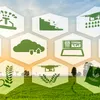How a data-led green revolution is changing the lives of Indian farmers
The convergence of government policy, technology, and consumption has led to the mushrooming of many agri companies. Together, these agritech startups are working to enhance crop output, increase farmer incomes, better farm management, and drive efficiencies in the farm-to-fork value chain.
The monsoons bring joy to several farmers, but, tears flow down the eyes of Chalapathy Naidu. He has, over the last 15 years, piled up debt of Rs 75 lakh. His five-acre orange farm in Anantpur district of Andhra Pradesh is a failed venture and has eaten into Chalapathy’s yearly income.
What started as an informal loan of Rs 10 lakh taken from local money lenders a decade ago, increased seven-fold, thanks to the interest. Every morning, a money lender would visit Chalapathy’s house and remind him sternly of the debt that needed to be paid up.
Tragically, COVID-19 ended Chalapathy’s life in August, and the entire debt fell upon his son Kiran Chalapathy.
“I work in the IT industry in Bengaluru. Everyone in the village knows my family and the fact that my father owed money to a lot of people. It is a matter of honour that I repay our debts. After all, we are farmers and cannot run away from our land,” says Kiran, who does not want to reveal where he works in Bengaluru.
India may be an agrarian nation, with the agriculture sector accounting for 18 percent of the country’s gross domestic product (GDP) and providing employment to 50 percent of its workforce, but farmers have for long been plagued by environmentally stimulated problems related to low yield and crop failure.
According to an International Labour Organisation (ILO) report, while agriculture continues to provide the maximum livelihood, its share in the national income continues to fall - from 22.6 percent in FY05 to 14.4 percent in FY19.
The problems have been many: high levels of fragmentation in the supply chain, failure to adopt and assimilate new technologies, exploitation by middlemen, loss of rightful earnings, and more.
Like labour markets, India’s agriculture sector has also been shackled by old and rigid regulations.
But change is coming.
The convergence of policy, technology, and consumption seems to have set the stage to empower the Indian farmer. And a clutch of startups, in retail and technology, are tapping the opportunity.
Jinesh Shah, Partner at Omnivore Ventures, believes that things are changing fast.
“New regulations have allowed farmers to transform themselves. Solutions for market linkages are aplenty. Farmers have access to information, thanks to the proliferation of smartphones and networks. A majority of them knows what the consumer wants,” he says.
“In the next 10 years, farm supply chains in India will be far more robust and connected. Manufacturing and agriculture will converge; there will be less wastage and exports will rise.”

Source: Omnivore's Vision 2030 report on Agriculture
The fact that the consumer is more aware and there is an insatiable rise in consumption in India is driving this convergence.
Advisory firm BCG says India’s retail market will be a $1 trillion opportunity by 2025, from the present $750 billion. It was $350 billion in size 15 years ago. The fact that the country has the youngest population in the world – 60 percent of its people are less than 30 years old – also has a bearing on the transformation.
What needs to transform?
The World Bank, calling India a “global agricultural powerhouse”, says three agriculture sector challenges will be “important to India’s overall development and the improved welfare of its rural poor”: raising agricultural productivity per unit of land, ensuring that agricultural growth responds to food security needs, and reducing rural poverty through a socially inclusive strategy.
According to leading agriculture company Syngenta, modern agriculture has many complex challenges as farming is a “complex, unpredictable, and individual business”.
In the coming years, farmers will need to learn how to:
· Cope with climate change, soil erosion, and biodiversity loss
· Satisfy consumers’ changing tastes and expectations
· Meet rising demand for more food of higher quality
· Invest in farm productivity
· Adopt and learn new technologies
· Stay resilient against global economic factors
· Inspire young people to stay in rural areas and become future farmers
Driving change through policy
A decade ago, retailers believed they could change the life of the farmer, but were hamstrung by the Agricultural Produce Market Committee (APMC), which had a very big say in how a private retailer/company worked with the farmers.
In June 2020, the central government announced that farmers and businesses could work together without having to be bound by APMC rules and this became the impetus for farmers to work directly with private companies.
Since then, things have changed on the ground.

Image Source: Shutterstock
The 93-acre Yeshwantpur mandi, an APMC yard, in Bengaluru North, is practically empty. This has nothing to do with COVID-19.
“Today there is a movement to link the market directly to the farm gate. Smartphone penetration, availability of data through Jio, WhatsApp, progressive government initiatives, and credit availability are only going to make farming better,” says Rohit S D, Principal at Bertelsmann India Investments.
Startups are building these market linkages and these developments are “leading governments to embrace technology to help farmers”.
“Farmers may not know Google, but they know WhatsApp. The quality of entrepreneurs in the agriculture sector is far better now than what we saw a few years ago. A good many agritech startups have emerged as mature companies,” Rohit says.
The convergence in market linkages, from farm to fork,led the government to ensure reforms in APMC yards, which were dominated by middlemen eating into farmer margins.
New ordinances issued by the President of India this year, such as the Farmers Produce Trade and Commerce Ordinance 2020 and the Farmers Agreement on Price Assurance and Farm Services Ordinance 2020, now let farmers decide their own fate when working with private players to reach the consumer.
In June 2020, the government also announced that the farmer need not go to any agricultural yard to sell produce. It has allowed private organisations to offer value-added services such as warehousing, logistics, and access to consumers without having to worry about paying the stipulated APMC charges.
In doing so, the government has empowered Farmer Producer Organisations, co-ops of farmers, to work directly with retailers and other companies.
These regulatory changes have allowed agritech startups such as , , , and , among several others, to partner with farmers and ensure that the agriculture sector sees transformation.

Women queue up to buy milk at a village in Northern India
Focus on better yields and prices
The first step in this journey is reimagining the farm and ensuring that the farmer gets a better price.
In Guntur, Andhra Pradesh, Bengaluru-based robotics startup Tartan Sense is working with red chilli farmers. The startup uses robots to prepare the fields for sowing by removing parasitic weeds.
This startup believes this is a large market. Every farmers pays, depending on the size of the farm, between Rs 20,000 to Rs 1 lakh towards manual labour, in every season, to clear the field of these parasitic plants.
TartanSense’s robots reduce the cost of clearing the field by a third. Using computer vision with a pre-loaded layout of the field, they can clear an acre of land of in 90 minutes; an average human will take three to four days to clear the field.
"This helps the farmer not only save costs, but also ensure that a large percentage of the crop is harvested. The applications of these robots are extensive, and our trials in Andhra Pradesh will help us scale this across the country,” says Jaisimha Rao, Co-founder of TartanSense.
Around five robots are hard at work in the fields of Guntur and are working with a collective of farmers in over 10 acres of land.
TartanSense estimates that manual removal of weeds results in an annual payout of $20 billion in the form of labour charges. Imagine this cost coming down to a third.
Down south from Guntur towards Nellore, Andhra Pradesh, the beaches of the Bay of Bengal house thousands of shrimp and fish farms. It is a $17 billion industry globally, and India’s production constitutes $6 billion of that market.
But there are problems aplenty. Every year, farmers struggle with understanding the pond water quality, feed conversion ratio, and how to standardise shrimp weight as per requirements of global food chains.
Startups like Chennai-based AquaConnect have come in to help.
Farmers were losing at least 30 percent of the shrimp harvest because they had no way to capture data other than listen to “friendly” advice. Each farmer earned Rs 1.5 lakh per acre at 70 percent yield capacity. If the remaining 30 percent of the crop was harvested, the increase could translate into Rs 50,000 per acre for the farmer.
"Indian farmers use anecdotal inferences to make decisions and in the process lose a lot of money. They need to use data.We use our technology so farmers can track the growth of shrimps.
"We collect data such as water quality, feeding information, growth rate of shrimp, and incidences of disease. This data helped increase yield as farmers used the inputs to make timely interventions,” says Rajamanohar, Co-founder of AquaConnect.
The machine learning and SaaS startup works with 20,000 farmers and connects them to shrimp hatcheries, shrimp feed companies, IoT companies, buyers, and bankers for credit. The Aqua Cred app helps farmers find lenders while the Aqua Connect platform offers pre and-post harvest services.
Using inputs to impact output
Change is also afoot in Kolar, Karnataka, which calls itself one of the largest producers of milk in the state.
At one of the dairies that belongs to the Karnataka Milk Federation (KMF), Bengaluru, Bengaluru-based StellApps is working with farmers to improve the quality and yield of the milk with data-led interventions. The startup has worked with 270 dairies with access to three million farmers and nine million cows.
How have they done this? By installing wearables on 500,000 cows to track their health. The endeavour is to use data to improve production of milk and increase the number of milk products such as cheese and butter.
According to the Department of Animal Husbandry, the average Indian cow produces eight to 12 litres of milk per day. Compare this with the US, where a cow produces 33 litres of milk per day. There, 35 percent of the milk production goes into the making of value-add products.
"Milk production is standardised for scale in India, but we have not solved for productivity and traceability, which is where we come in,” says Ranjith Mukundan, Co-founder of StellApps.
The startup has so far checked the health of three million cows to gauge their ability to produce quality milk.
Why is this significant? Every farmers is paid Rs 25 per litre, translating into an income of Rs 300 for the average production of 12 litres of milk per cow. An increase in yield would lead to additional income and a better life.
The agri-input market is a $5 billion market, according to FICCI, and will be a $8.5 billion market by 2025.
Startups are keenly aware that using the right inputs can help farmers get better output.
Delhi-based Dehaat works with farmers in Bihar, Jharkhand, and Orissa and enables them to access the right inputs in less than 24 hours to less than a week. As many as 500 agri-businesses use its platform; the startup also works with 300,000 farmers.
“When these farmers plan their cropping cycle they have neither studied demand nor planned their production. They need to be trained on the benefits of multi-cropping patterns and that they can use the DeHaat platform to plan their purchase of inputs. We build direct access to farmers with businesses,” says Shashank Kumar, Founder of Dehaat.

Founders of DeHaat in a potato field
Using tech to manage nutrition quality and wastage
While these startups focus on improving yield, others are intervening to look at the quality of produce and ensure that there is no wastage.
Travel to the sprawling wheat fields of Punjab and you will find that quality checks have become the norm at the farm gate.
Chandigarh-based startup AgNext helps food manufacturing companies source quality produce after it analyses samples for protein and fat in a matter of minutes. Their portable testing devices and SaaS platform are changing the way organisations buy produce and helping them process better quality food.
Taranjeet Singh Bhamra, Co-founder of AgNext, says: “To measure the output, you need to improve the input so that farmers can benefit during the harvest of grains, oil seeds, and pulses.”
He adds that digital technologies and access to machines that crunch real-time data give farmers have the power to optimise inputs during the sowing season.
“Just like an , the farmer should be given a soil health card. We help corporate companies source produce with the right amount of protein, fat, moisture, ash, and gluten content. We can do this in 30 seconds with our machines,” he says.
AgNext works with 25 agri-companies and is also working with the government to create an agriculture stack for India to empower farmers to use data to procure better inputs and plan for better yield. It uses 180 data points to ensure farmers get better pricing for their produce.
Solving the storage problem
Once the produce is harvested, it needs to be transported. The product suffers value and wastage loss during transportation to retail chains. Ernst and Young pegs the wastage loss in the supply chain at 30 percent.
A few startups are solving for the problem of produce wastage.
“Change is happening in agriculture. Several micro trends are contributing to the macro trend. There is a complex supply chain for each item and startups are solving these complexities. We are tell companies about the quality of the produce they source. We analyse images of the fruits and vegetables sent to us and can tell how the quality of the produce is deteriorating over time," says Milan Sharma, Co-founder of Intello Labs.
The company has scanned 100 million images of fruits and vegetables to prevent wastage, from sourcing to consumption, and has benefited large retailers like Reliance Fresh and manufacturers such as Dole.
The next step is storage, and it’s an important one. But moving grains from the farm gate to the warehouse is no easy task; it requires the use of technology and needs a lot of money to be spent finding a warehouse.
According to Research and Markets, India’s agricultural warehousing market was valued at $1.9 billion in 2019, and is expected to reach $45 billion by the end of 2024.
Agritech company Arya says only 30 percent of the grains produced in the country go to mandis; the rest are sold in an unorganised manner to various wholesale and retail outlets.
The startup uses technology to help FPOs store commodities by accessing more than 1,500 warehouses. It provides financing and market linkages for farmers, and at present works with 450 FPOs and 300,000 farmers.
“Most farmers sell their grains because they are not able to store the produce. They sometimes sell for less because they cannot find a nearby warehouse," says Prasanna Rao, Co-founder of Arya, a fintech and warehouse marketplace.
"The opportunity is large, with 8,000 FPOs and 10,000 more likely to be set up. We handle 40 crops across 20 states,” he adds.
His startup has given “Rs 250 crore in loans and stored grains worth $1 billion in our warehouses”.

Source: Omnivore Vision 2030 report on Indian Agriculture
Several other agritech startups such as PEAT, , , and are also bringing in change with their technology and by partnering with farmers.
All these startups have one thing in common: they are using data to make the seed-to-farm-to-fork revolution a complete reality.
India exports $30 billion worth of agricultural products, according to the Agriculture Ministry, and has plans to increase this to $100 million in five years. This can only be fuelled by the convergence of technology in supply chain, production, and sourcing of inputs, aided by India’s rising consumption.
Edited by Teja Lele











